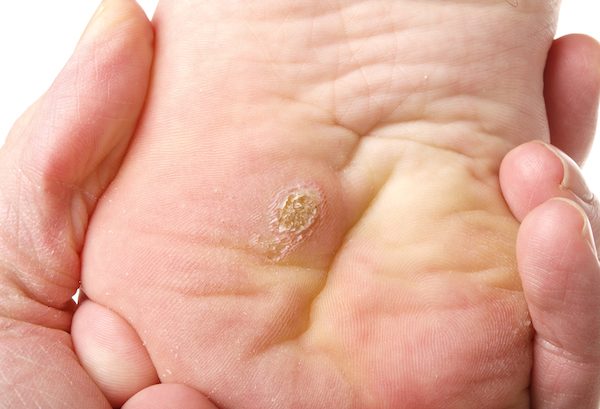Corns
Callosities also known as corns, are toughened areas in the skin, as a result of repeated pressure or repeated contact with rough surfaces. They are most common on the hands and feet but appear localized to the area that bears repeated pressure or abrasion.
CAUSES
Corns and calluses arise from hyperkeratosis, a normal physiological response to chronic excessive pressure or friction on the skin.
The outermost layer of skin called the stratum corneum is maintained as a hard, protective, layer by the process of keratin deposition (keratinisation). The stratum corneum is thus maintained as a highly protective sheath over the skin. In hyperkeratosis, there is excess deposition of keratin over the skin as a result of repeated pressure or shear strain that chronically displaces or disrupts the stratum corneum. This excess deposition may happen either locally or in a diffuse manner depending upon individual tendencies and the nature of stresses involved.
Often, callosities are found in sensitive areas of the body where the overlying skin is exposed to repeated wear and tear. They are the body’s natural response to repeated moderate and constant, pressures. Callosities are commoner over the skin overlying the weight bearing areas of the body while the corns may appear on non-weight bearing areas of the palms and soles.
The corn is a localized collection of dead skin cells which have a very hard (indurated) centre. Many clinicians believe that a typical callosity differs from a corn because, its center unlike the corn is softer and not a hardened core.
Occasionally, when corns become painful, they are called ‘bunions’.
The most common sites for clavus formation are the feet, specifically the dorsolateral aspect of the fifth toe for heloma durum, in the fourth interdigital web of the foot for heloma molle, and under the metatarsal heads for calluses.
SYMPTOMS
- Affected area of the skin appears rough, thickened and hyperkeratotic.
- It is common to find the callus present with fungal infections.
- Pain: on applying direct pressure is not uncommon. Some callosities can be so painful that they seriously alter the person’s gait and daily activities.
- Occasionally – presence of a keratin plug in the centre of the callus.
HOMOEOPATHIC TREATMENT
Callosities and corns show promising results with homeopathic treatment. Homeopathic medicines can relieve the pain as well as recurrence of the callosities. Painful callosities that cannot be scrubbed by pumice stones respond well to homeopathic medications taken internally.

